Optimized Energy Harvesting, Cluster-Head Selection and Channel Allocation for IoTs in Smart Cities
Abstract
:1. Introduction
- An IoT framework is presented with a focus on energy efficiency, energy balancing and QoS. To achieve energy efficiency, a scheme is developed to assign RF sources to IoT devices in such a way that RF devices can harvest the energy up to the maximum.
- A clustering mechanism is introduced to cluster the IoT devices in a close proximity, and a cluster head (CH) selection strategy is proposed for that cluster. The cluster-member with the highest residual energy is selected as a CH to balance the energy consumption among the IoT devices in that cluster.
- To fulfill the QoS requirements of IoTs, a novel integer linear program (ILP)-based channel-allocation scheme is presented to allocate the best possible channels to IoT devices during the reporting process.
- To evaluate the performance of the proposed framework, exhaustive simulations are carried out by varying different parameters (e.g., number of channels, the number of devices, harvesting sources, etc.).
2. Related Work
3. System Model
3.1. Network Model
3.2. Frame Format
3.3. Energy Harvesting Model
3.4. Energy Consumption Model
3.5. Spectrum Sensing and Predicted Idle Time of Channels
3.6. Channel Capacity and Overall Throughput of a Cluster
4. Problem Formulation
4.1. Energy Efficient Association Mechanism for IoTs
Operational Modes for RF Energy Harvesting
4.2. Association Mechanism
- The RMN forms a table for the location of ambient RF sources available at a given time instant. The table contains the source number and corresponding location.
- The RMN directs a message to the IoT devices to provide their location.
- The IoT devices reply with a message to RMN with x, y coordinates of IoT devices.
- The RMN forms a table that contains the location information of node along with its cluster.
- After the collection of the desired data, the RMN performs an optimization algorithm for optimal association between IoT devices and RF sources.
Bipartite Graph and Maximum Edge Biclique Graphs
| Algorithm 1 Heuristic algorithm to extract biclique graph from bipartite graph |
| Require: A bipartite graph G(N,S,ε) |
| Ensure: Maximum edge biclique graph |
| Initialize edge variable |
| for (i: 1 to N) do |
| for (j: 1 to S) do |
| if then |
| Estimate using Equation (1) |
| end if |
| end for |
| Find maximum |
| Find maximum and |
| end for |
| return |
4.3. Energy Efficient Clustering Method
Cluster Head Selection
| Algorithm 2 Energy pptimized cluster-head selection |
| Require: |
| • IoT devices |
| • Residual energy of IoT device |
| • Energy threshold |
| Ensure: Cluster-Head selection |
| Initialize selection variable |
| Initialize intermediate variable |
| for (i: 1 to ) do |
| Compute residual energy of each node |
| if then |
| end if |
| end for |
| return |
4.4. Residual Energy and PU Activity Aware Throughput and QoS Optimized Channel Allocation
| Algorithm 3 Energy and PU activity-aware throughput optimized channel allocation |
| Require: |
| • Channel capacity |
| • Predicted idle time of channels |
| • Transmission energy of IoTs |
| • Residual energy of IoT device |
| • Transmission power of IoTs |
| • Capacity threshold |
| • Energy threshold |
| Ensure: Optimal channel allocation |
| 1. Formation of objective function |
| 2. Equate |
| 3. Form matrix and vector for ≥ constraint-1 and matrix , vector for ≥ constraint-2 and multiply it by -1 |
| 4. Form matrix and vector for ≤ constraint-3 and for ≤ constraint-4 |
| 5. Form standard linear non-equality constraint matrix and vector |
| 6. Declare linear equality constraint matrix and vector |
| 7. Declare lower and uper bounds: vectors lb and ub |
| 8. Declare number of integer variables, i.e., intvars |
| 9. Use function intlinprog to get optimal solution |
| return |
5. Performance Evaluation
6. Conclusions
Acknowledgments
Author Contributions
Conflicts of Interest
References
- Abbas, Z.; Yoon, W. A Survey on Energy Conserving Mechanisms for the Internet of Things: Wireless Networking Aspects. Sensors 2015, 15, 24818–24847. [Google Scholar] [CrossRef] [PubMed]
- Yun, J.; Ahn, I.-Y.; Choi, S.-C.; Kim, J. TTEO (Things Talk to Each Other): Programming Smart Spaces Based on IoT Systems. Sensors 2016, 16, 467. [Google Scholar] [CrossRef] [PubMed]
- Li, F.; Han, Y.; Jin, C. Practical access control for sensor networks in the context of the Internet of Things. Comput. Commun. 2016, 89–90, 154–164. [Google Scholar] [CrossRef]
- Oh, D.; Kim, D.; Ro, W.W. A Malicious Pattern Detection Engine for Embedded Security Systems in the Internet of Things. Sensors 2014, 14, 24188–24211. [Google Scholar] [CrossRef] [PubMed]
- Skouby, K.E.; Lynggaard, P. Smart home and smart city solutions enabled by 5G, IoT, AAI and CoT services. In Proceedings of the 2014 International Conference on Contemporary Computing and Informatics (IC3I), Mysore, India, 27–29 November 2014; pp. 874–878.
- Andrews, J.G.; Buzzi, S.; Choi, W.; Hanly, S.V.; Lozano, A.; Soong, A.C.K.; Zhang, J.C. What will 5G be? IEEE J. Sel. Areas Commun. 2014, 32, 1065–1082. [Google Scholar] [CrossRef]
- Zanella, A.; Bui, N.; Castellani, A.; Vangelista, L.; Zorzi, M. Internet of things for smart cities. IEEE Internet Things J. 2014, 1, 22–32. [Google Scholar] [CrossRef]
- Verma, P.; Kumar, A.; Rathod, N.; Jain, P. Towards an IoT based water management system for a campus. In Proceedings of the 2015 IEEE First International Smart Cities Conference (ISC2), Guadalajara, Mexico, 25–28 October 2015; pp. 1–6.
- Gaura, A.; Scotneya, B.; Parra, G.; McCleana, S. Smart City Architecture and Its Applications Based on IoT. Comput. Sci. 2015, 52, 1089–1094. [Google Scholar] [CrossRef]
- Seyedi, A.; Sikdar, B. Energy efficient transmission strategies for body sensor networks with energy harvesting. IEEE Trans. Commun. 2010, 58, 2116–2126. [Google Scholar] [CrossRef]
- Huang, H.; Lau, V. Decentralized delay optimal control for interference networks with limited renewable energy storage. IEEE Trans. Signal Process. 2012, 60, 2552–2561. [Google Scholar] [CrossRef]
- Zubair, S.; Fisal, N. Reliable geographical forwarding in cognitive radio sensor networks using virtual clusters. Sensors 2014, 14, 8996–9026. [Google Scholar] [CrossRef] [PubMed]
- Sudevalayam, S.; Kulkarni, P. Energy harvesting sensor nodes: Survey and implications. IEEE Commun. Surv. Tutor. 2011, 13, 443–461. [Google Scholar] [CrossRef]
- Varshney, L.R. Transporting information and energy simultaneously. In Proceedings of the 2008 IEEE International Symposium on Information Theory, Toronto, ON, Canada, 6–11 July 2008.
- Zhang, Y.; Zhang, F.; Shakhsheer, Y.; Jason, D.S.; Klinefelter, A.; Nagaraju, M.; Boley, J.; Pandey, J.; Shrivastava, A.; Eric, J.C.; et al. A Batteryless 19 W MICS/ISM-Band Energy Harvesting Body Sensor Node SoC for ExG Applications. IEEE J. Solid State Circuits 2013, 48, 199–213. [Google Scholar] [CrossRef]
- Doost, R.; Chowdhury, K.R.; di Felice, M. Routing and link layer protocol design for sensor networks with wireless energy transfer. In Proceedings of the 2010 IEEE Global Telecommunications Conference, Miami, FL, USA, 6–10 December 2010.
- Zi, L.; Yang, P.; Zhang, W.; Qiao, D. J-RoC: A joint routing and charging scheme to prolong sensor network lifetime. In Proceedings of the 19th IEEE International Conference on Network Protocols (ICNP), Vancouver, AB, Canada, 17–20 October 2011; pp. 373–382.
- Tong, B.; Li, Z.; Wang, G.; Zhang, W. How wireless power charging technology affects sensor network deployment and routing. In Proceedings of the IEEE International Conference on Distributed Computing Systems (ICDCS), Genoa, Italy, 21–25 June 2010; pp. 438–447.
- Park, S.; Kim, H.; Hong, D. Cognitive radio networks with energy harvesting. IEEE Trans. Wirel. Commun. 2013, 12, 1386–1397. [Google Scholar] [CrossRef]
- Lee, S.; Zhang, R.; Huang, K. Opportunistic wireless energy harvesting in cognitive radio networks. IEEE Trans. Wirel. Commun. 2013, 12, 4788–4799. [Google Scholar] [CrossRef]
- Krikidis, I. Simultaneous information and energy transfer in large-scale networks with/without relaying. IEEE Trans. Wirel. Commun. 2014, 62, 900–912. [Google Scholar] [CrossRef]
- Ding, Z.; Krikidis, I.; Sharif, B.; Poor, H.V. Wireless Information and Power Transfer in Cooperative Networks With Spatially Random Relays. IEEE Trans. Wirel. Commun. 2014, 13, 4440–4453. [Google Scholar] [CrossRef]
- Mekikis, P.V.; Lalos, A.S.; Antonopoulos, A.; Alonso, L.; Verikoukis, C. Wireless Energy Harvesting in Two-Way Network Coded Cooperative Communications: A Stochastic Approach for Large Scale Networks. IEEE Commun. Lett. 2014, 18, 1011–1014. [Google Scholar] [CrossRef]
- Huang, K.; Kountouris, M.; Li, V.O.K. Coverage of renewable powered cellular networks. In Proceedings of the 14th IEEE International Conference on Communication Systems (ICCS), Macau, China, 19–21 November 2014.
- Song, Y.; Zhao, M.; Zhou, W.; Han, H. Throughput-optimal user association in energy harvesting relay-assisted cellular networks. In Proceedings of the 6th IEEE International Conference on Wireless Communications and Signal Processing (WCSP), Hefei, China, 23–25 October 2014.
- Cerpa, A.; Estrin, D. ASCENT: Adaptive self-configuring sensor networks topologies. IEEE Trans. Mob. Comput. 2004, 3, 272–285. [Google Scholar] [CrossRef]
- Chen, B.; Jamieson, K.; Balakrishnan, H.; Morris, R. Span: An energy-efficient coordination algorithm for topology maintenance in ad hoc wireless networks. Wirel. Netw. 2002, 8, 481–495. [Google Scholar] [CrossRef]
- Panahi, N.; Payandeh, A.; Rohi, H.O.; Haghighi, M.S. Adaptation of LEACH routing protocol to cognitive radio sensor networks. In Proceedings of the Sixth International Symposium on Telecommunications (IST), Tehran, Iran, 6–8 November 2012; pp. 541–547.
- Kumar, T.D.; Aseri, T.C.; Patel, R.B. EEHC: Energy efficient heterogeneous clustered scheme for wireless sensor networks. Comput. Commun. 2009, 32, 662–667. [Google Scholar] [CrossRef]
- Leu, J.S.; Chiang, T.H.; Yu, M.C.; Su, K.W. Energy Efficient Clustering Scheme for Prolonging the Lifetime of Wireless Sensor Network With Isolated Nodes. IEEE Commun. Lett. 2015, 19, 259–262. [Google Scholar] [CrossRef]
- Mihaela, I.C.; Eduardo, M.; Margarita, S.J.; Julio, R.B.; Javier, R.; Antonio, J.C. Energy Efficiency and Quality of Data Reconstruction Through Data-Coupled Clustering for Self-Organized Large-Scale WSNs. IEEE Sens. J. 2016, 16, 5010–5020. [Google Scholar]
- Zeng, F.; Xu, J. Leasing-Based Performance Analysis in Energy Harvesting Cognitive Radio Networks. Sensors 2016, 16, 305. [Google Scholar] [CrossRef] [PubMed]
- Homayounzadeh, A.; Mahdavi, M. Quality of Service Provisioning for Real-Time Traffic in Cognitive Radio Networks. IEEE Commun. Lett. 2015, 19, 467–470. [Google Scholar] [CrossRef]
- Aslam, S.; Lee, K.G. CSPA: Channel selection and parameter adaptation scheme based on genetic algorithm for cognitive radio ad hoc networks. EURASIP J. Wirel. Commun. Netw. 2012, 2012, 349. [Google Scholar] [CrossRef]
- Shahid, A.; Aslam, S.; Kim, H.S.; Lee, K.G. CSIT: Channel state and idle time predictor using a neural network for cognitive LTE-Advanced network. EURASIP J. Wirel. Commun. Netw. 2013, 2013, 203. [Google Scholar] [CrossRef]
- Shahid, A.; Aslam, S.; Kim, H.S.; Lee, K.G. Energy-efficient downlink resource management in self-organized OFDMA-based two-tier femtocell networks. EURASIP J. Adv. Signal Process. 2015, 2015, 42. [Google Scholar] [CrossRef]
- Aslam, S.; Shahid, A.; Lee, K.G. Reliable, Efficient, and Power Optimized Control-Channel Selection Scheme for Cognitive Radio Networks. Math. Probl. Eng. 2013, 2013, 567581. [Google Scholar] [CrossRef]
- Aslam, S.; Shahid, A.; Lee, K.G. Spectrum sharing optimization with QoS guarantee in cognitive radio networks. Comput. Electr. Eng. 2013, 39, 2053–2067. [Google Scholar] [CrossRef]
- Jain, N.; Bohara, V.A. Energy Harvesting and Spectrum Sharing Protocol for Wireless Sensor Networks. IEEE Commun. Lett. 2015, 4, 697–700. [Google Scholar] [CrossRef]
- Shafie, A.E.; Ashur, M.; Khattab, T.; Mohamed, A. On spectrum sharing between energy harvesting cognitive radio users and primary users. In Proceedings of the 2015 International Conference on Computing, Networking and Communications (ICNC), Anaheim, CA, USA, 16–19 February 2015; pp. 214–220.
- Nishimoto, H.; Kawahara, Y.; Asami, T. Prototype implementation of ambient RF energy harvesting wireless sensor networks. In Proceedings of the 2010 IEEE SENSORS, Waikoloa, HI, USA, 1–4 November 2010.
- Zhao, Q.; Geirhofer, S.; Tong, L.; Sadleret, B.M. Opportunistic Spectrum Access via Periodic Channel Sensing. IEEE Trans. Signal Process. 2008, 56, 785–796. [Google Scholar] [CrossRef]
- Han, J.A.; Jeon, W.S.; Jeong, D.G. Energy-Efficient Channel Management Scheme for Cognitive Radio Sensor Networks. IEEE Trans. Veh. Technol. 2011, 60, 1905–1910. [Google Scholar] [CrossRef]
- Bicen, A.O.; Akan, O.B. Reliability and congestion control in cognitive radio sensor networks. J. Ad Hoc Netw. 2011, 9, 1154–1164. [Google Scholar] [CrossRef]
- Lia, X.; Wangb, D.; McNaira, J.; Chenc, J. Dynamic spectrum access with packet size adaptation and residual energy balancing for energy-constrained cognitive radio sensor network. J. Netw. Comput. Appl. 2014, 41, 157–166. [Google Scholar] [CrossRef]
- Shah, G.A.; Gungor, V.C.; Akan, O.B. A Cross-layer design for QoS support in Cognitive Radio Sensor Networks for Smart Grid applications. In Proceedings of the 2012 IEEE International Conference on Communications (ICC), Ottawa, ON, Canada, 10–15 June 2012; pp. 1398–1402.
- Aslam, S.; Hasan, N.U.; Shahid, A.; Jang, J.W.; Lee, K.-G. Device Centric Throughput and QoS Optimization for IoTs in a Smart Building Using CRN-Techniques. Sensors 2016, 16, 1647. [Google Scholar] [CrossRef] [PubMed]
- West, D.B. Introduction to Graph Theory, 2nd ed.; Prentice Hall: Upper Saddle River, NJ, USA, 2001. [Google Scholar]
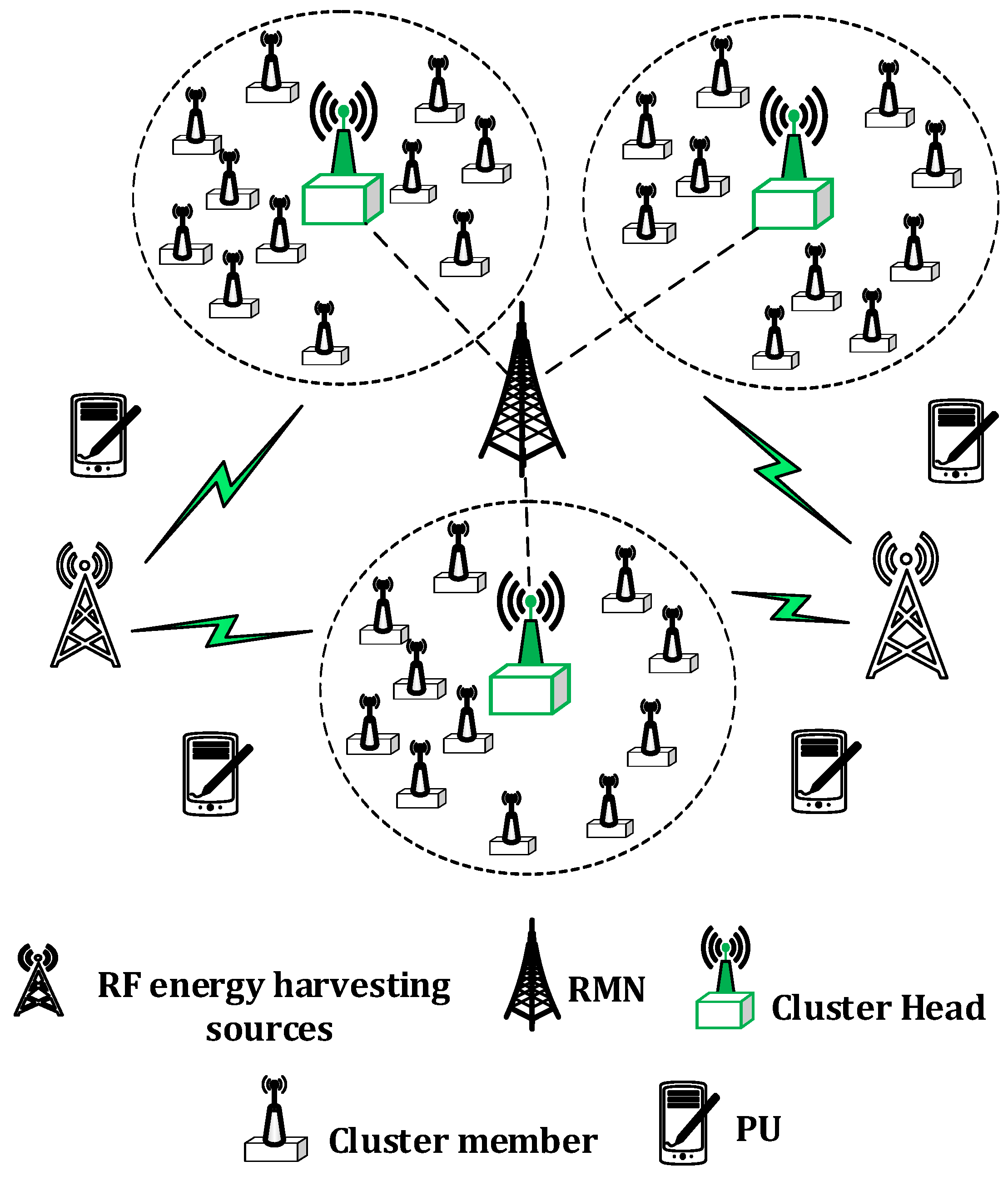
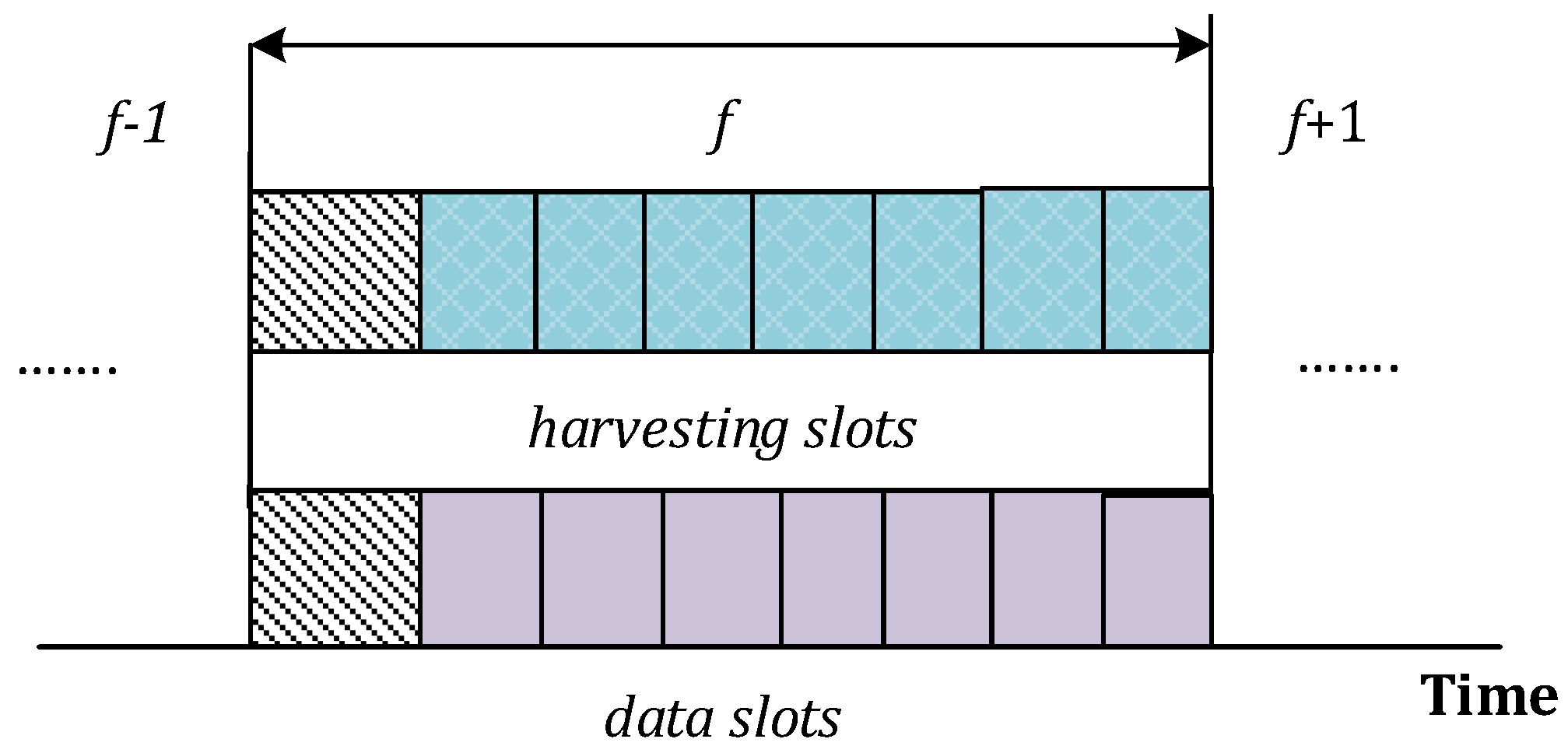
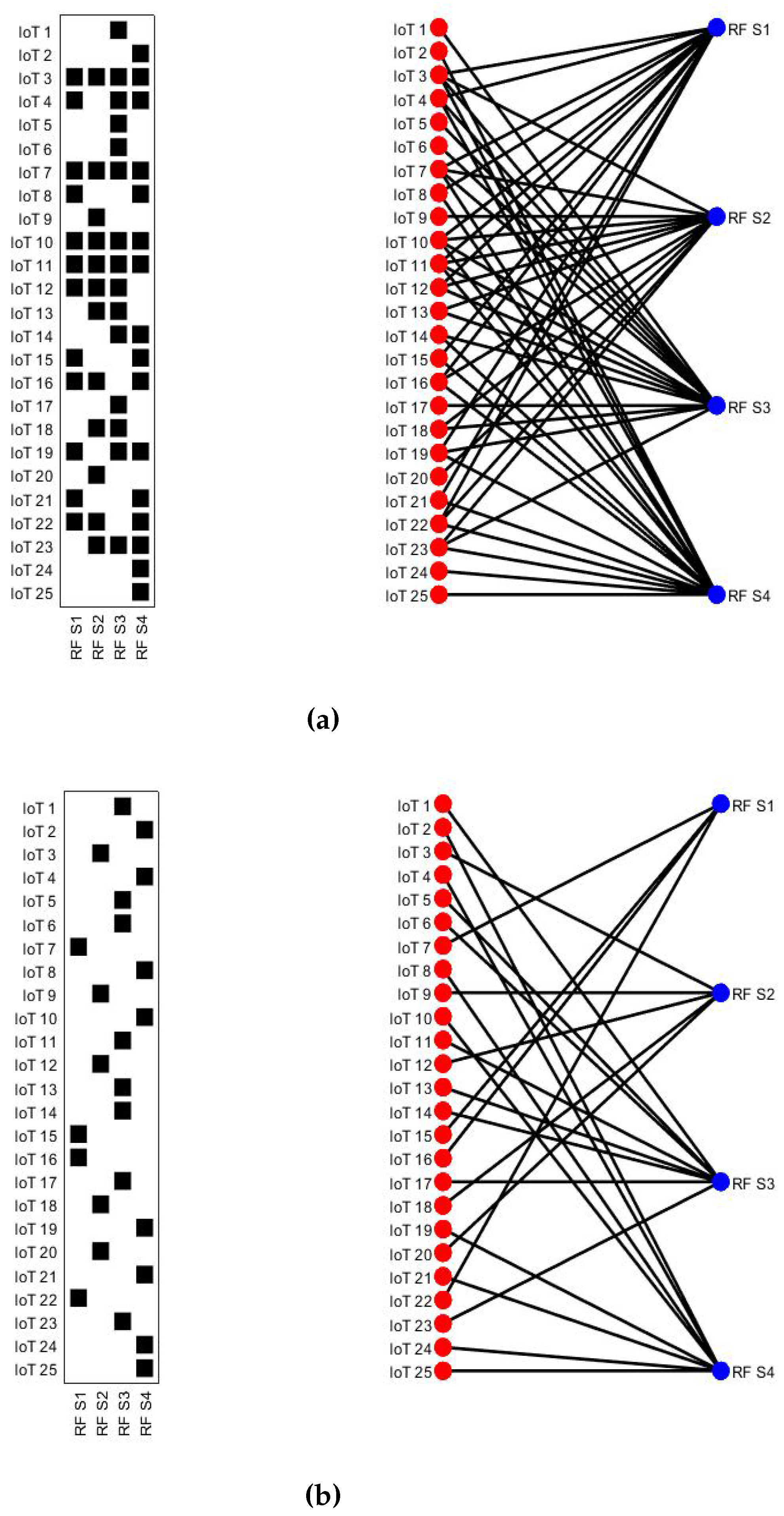
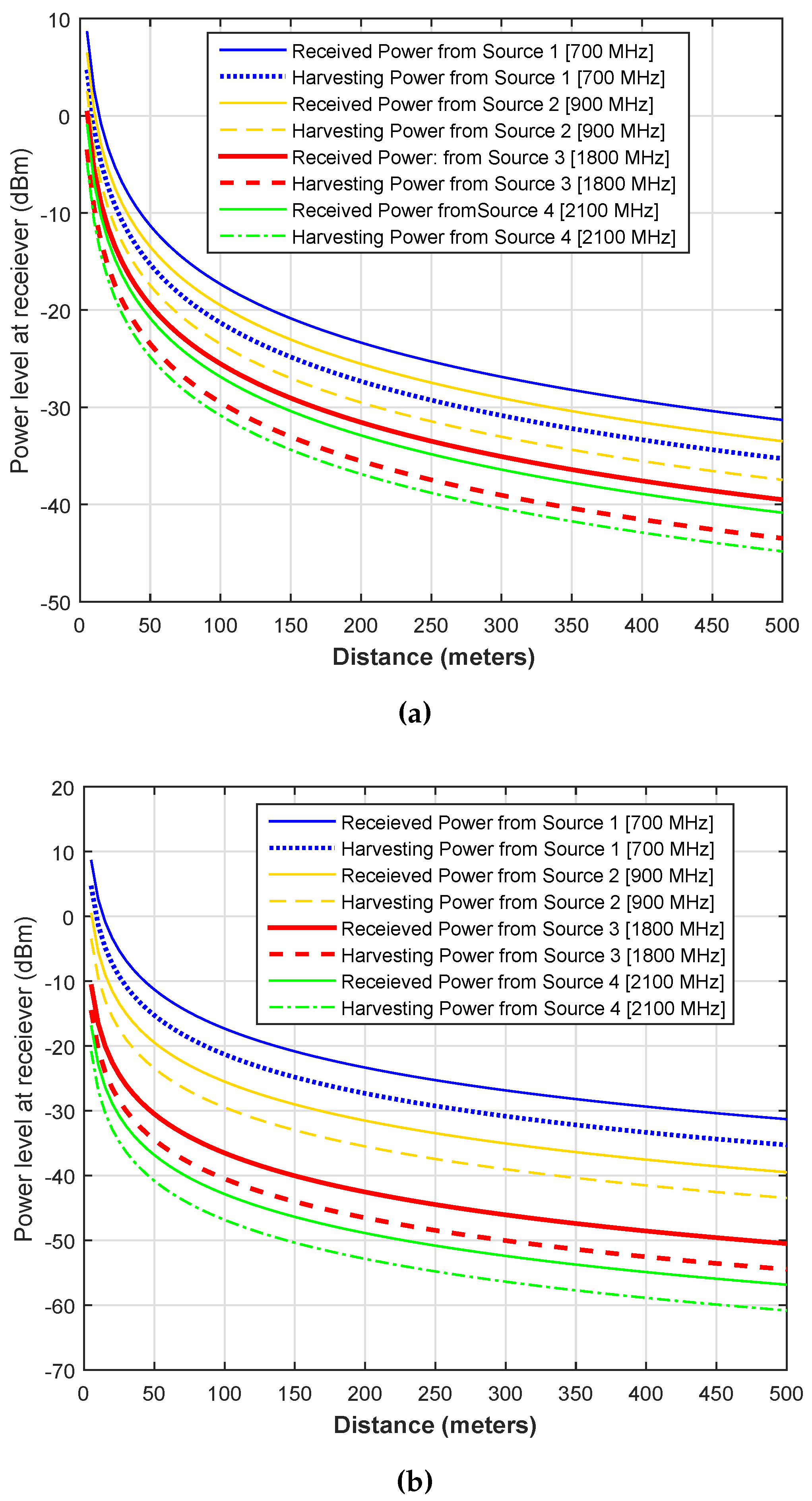
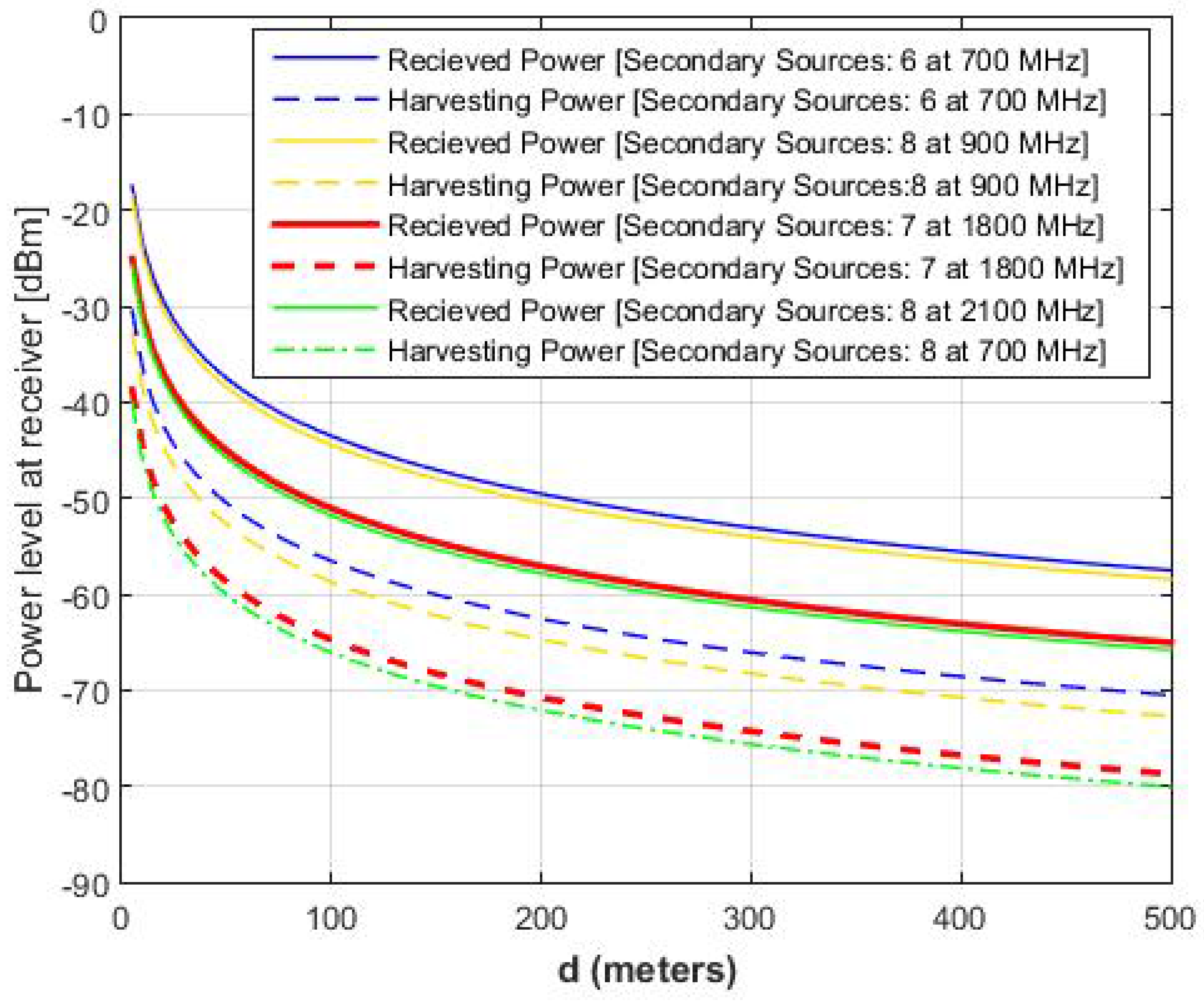
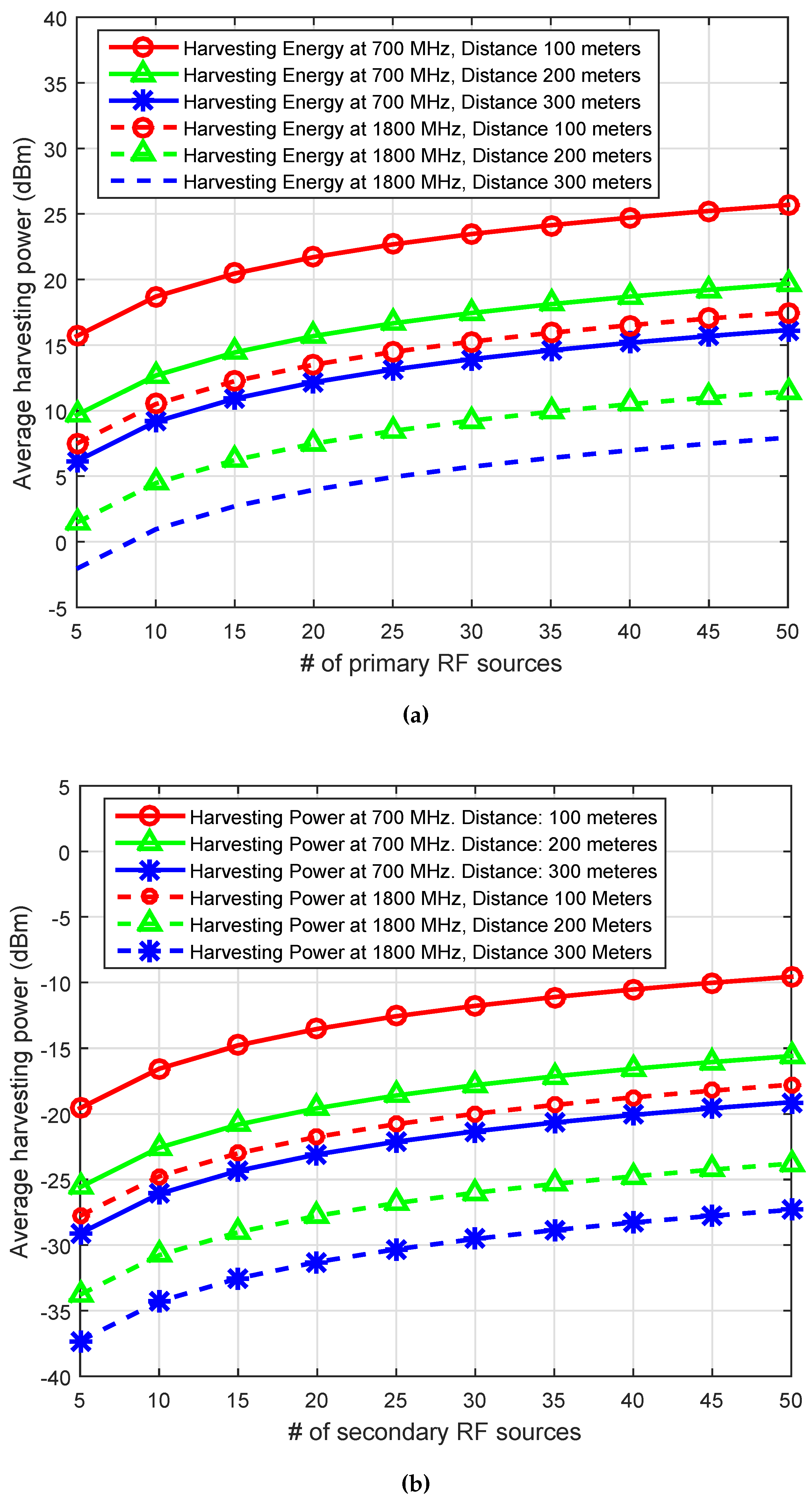
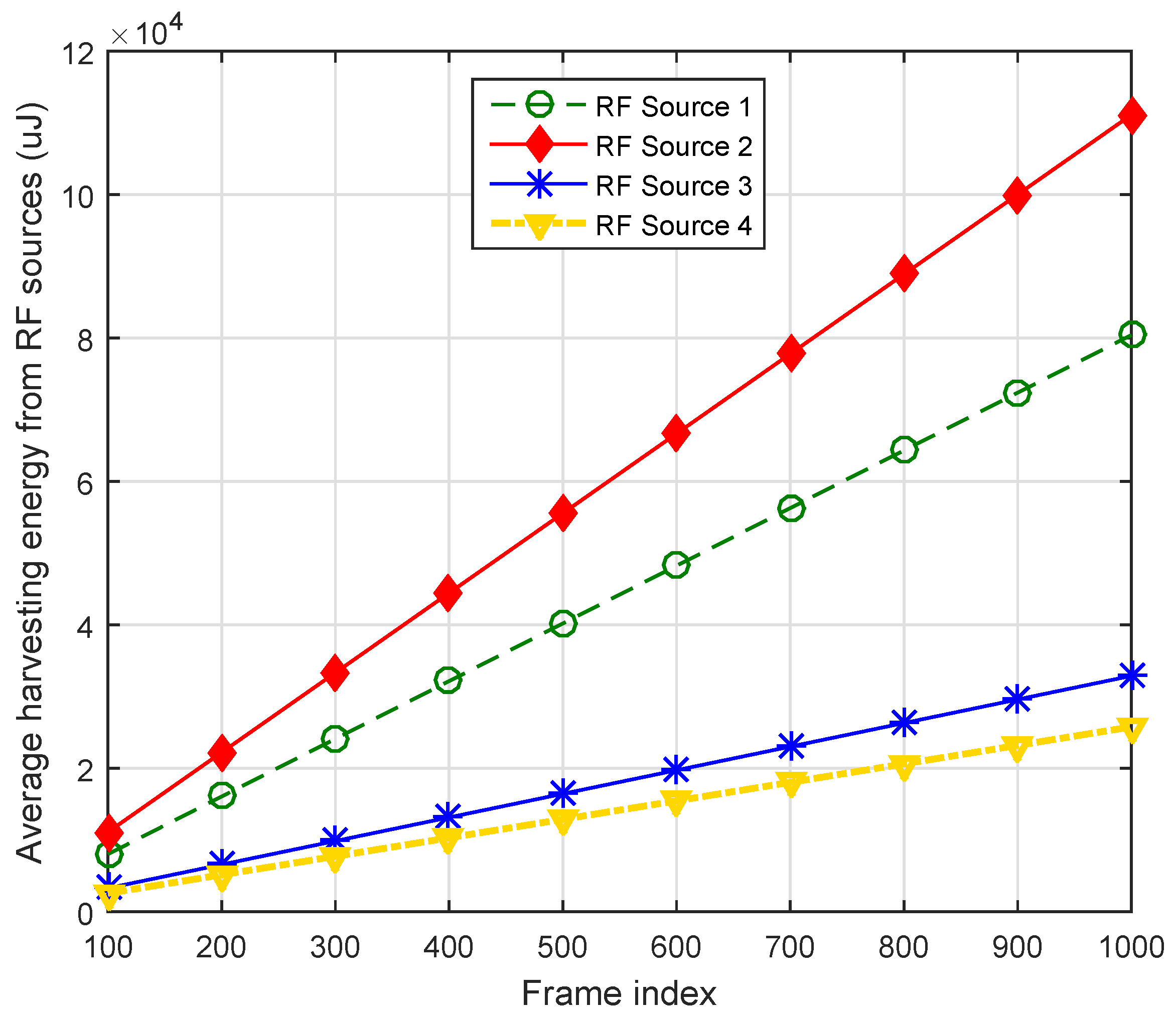
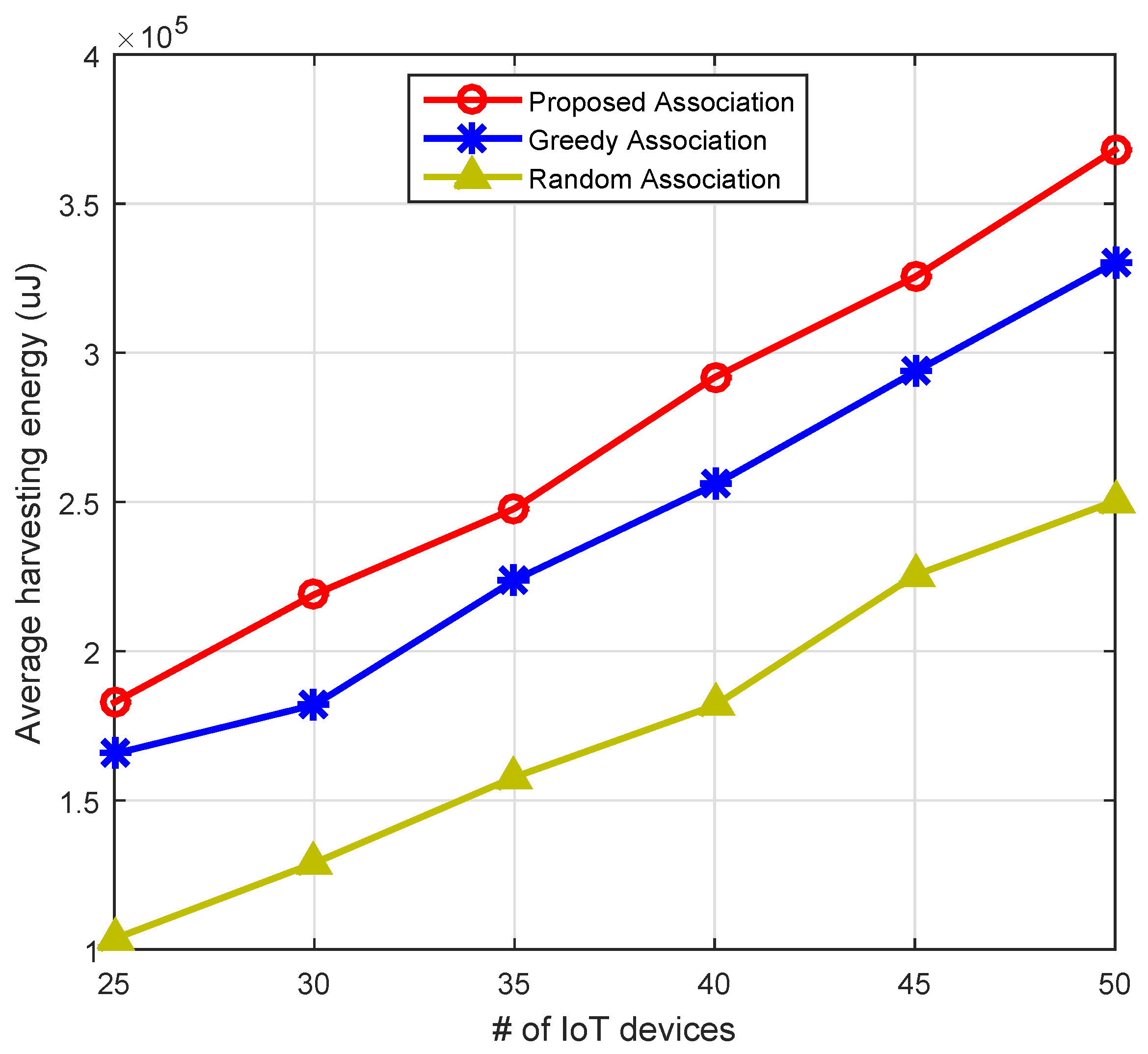
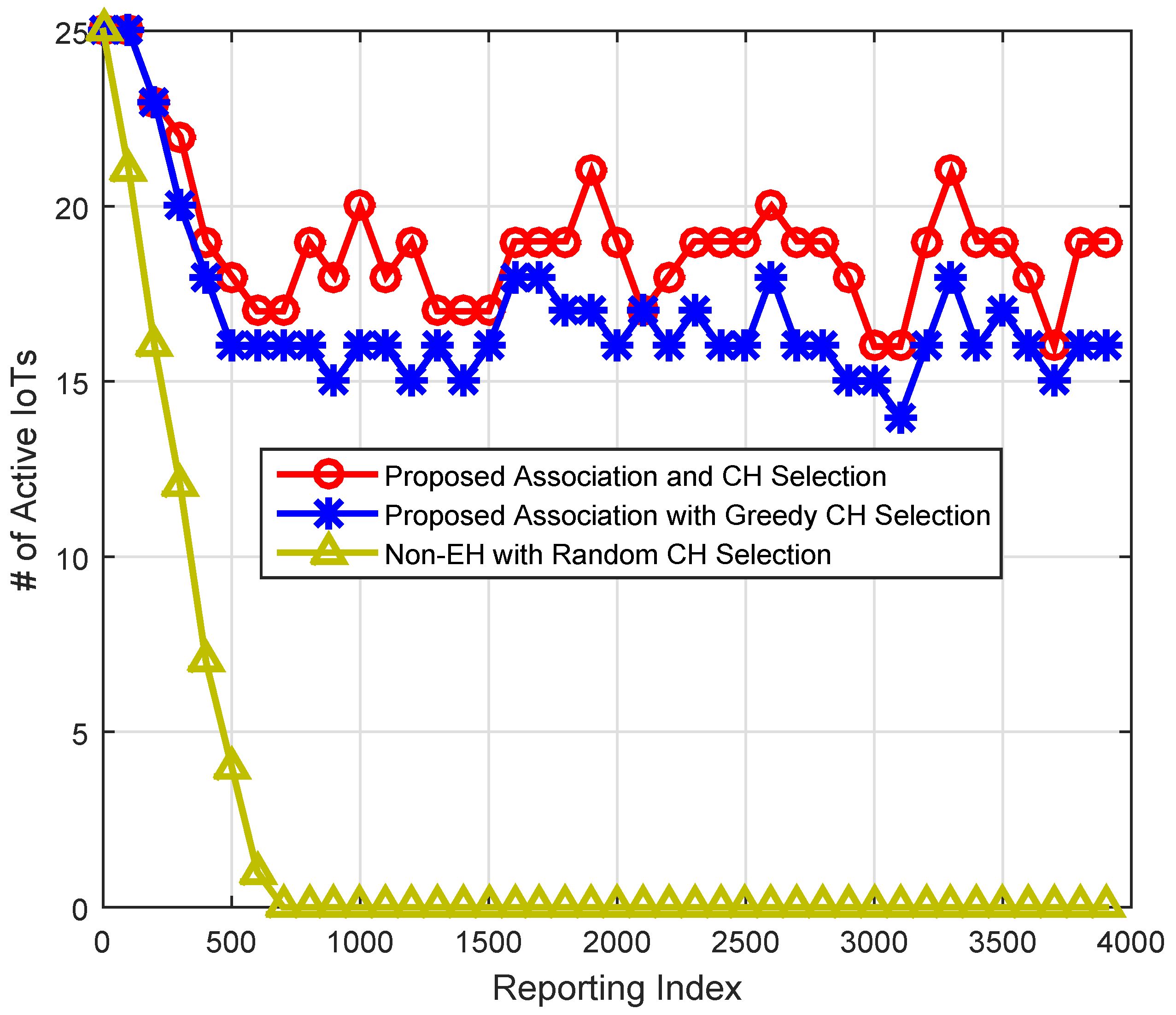

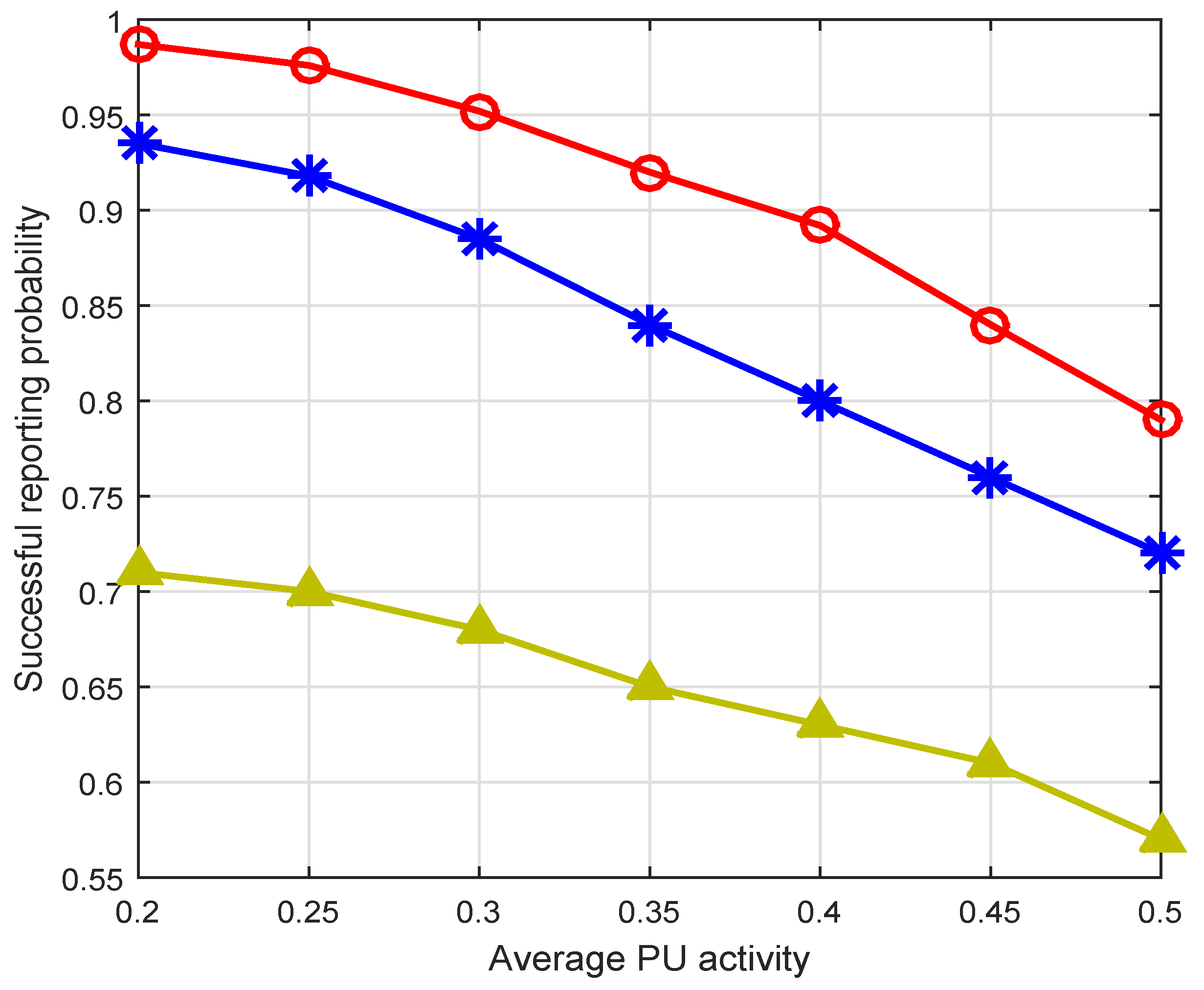
| Symbols | Meaning |
|---|---|
| Objective functions | |
| Number of IoT devices | |
| Number of channels | |
| Number of RF sources | |
| i | Subscript of IoT devices |
| j | Subscript of RF sources |
| k | Subscript of RF channels |
| harvested energy of IoT device i from RF source k | |
| harvested energy from primary RF source | |
| harvested energy from secondary RF source | |
| Transmission power of RF source k | |
| η | Harvesting efficiency |
| harvesting time | |
| Link gain of an IoT device | |
| Link gain of an RF source | |
| Distance between RF source and IoT device | |
| α | Pathloss exponent |
| λ | Wavelength |
| Threshold for energy detector in spectrum-sensing | |
| Q | Size of reporting packet |
| Binary decision variable for channel allocation | |
| Binary decision variable for CH selection |
| Modes | IoTs | RF Sources | Complexity | Requirements |
|---|---|---|---|---|
| 1 | Fixed Antenna | Homogeneous | Very Low | Switch on |
| 2 | Fixed Antenna | Heterogeneous | Very Low | Switch on |
| 3 | Cognitive Antenna | Homogeneous | Low | Tunning |
| 4 | Cognitive Antenna | Heterogeneous | Medium | Tuning & clustering |
| Parameters | Values |
|---|---|
| Power of primary RF source | 46 dBm |
| Power of secondary RF source | 16 dBm |
| Noise power spectral density | −110 dBm/Hz |
| Channels | 10∼30 |
| PU activity | 0.0∼0.6 |
| Sensing interval | 0.1 msec |
| Modulation scheme | MQAM |
| Constellation size | 4 |
| Constellation size | 4 |
| Size of reporting packet Q | 10 KB |
| Transmission Power of IoTs | 10 dBm |
| Spectrum sensing Power of IoTs | 4 dBm |
| Energy consumption of circuitry | 50 nJ/bit |
| History partitions | 3 |
| Weights [] | [0.6 0.25 0.15] |
© 2016 by the authors; licensee MDPI, Basel, Switzerland. This article is an open access article distributed under the terms and conditions of the Creative Commons Attribution (CC-BY) license (http://creativecommons.org/licenses/by/4.0/).
Share and Cite
Aslam, S.; Hasan, N.U.; Jang, J.W.; Lee, K.-G. Optimized Energy Harvesting, Cluster-Head Selection and Channel Allocation for IoTs in Smart Cities. Sensors 2016, 16, 2046. https://doi.org/10.3390/s16122046
Aslam S, Hasan NU, Jang JW, Lee K-G. Optimized Energy Harvesting, Cluster-Head Selection and Channel Allocation for IoTs in Smart Cities. Sensors. 2016; 16(12):2046. https://doi.org/10.3390/s16122046
Chicago/Turabian StyleAslam, Saleem, Najam Ul Hasan, Ju Wook Jang, and Kyung-Geun Lee. 2016. "Optimized Energy Harvesting, Cluster-Head Selection and Channel Allocation for IoTs in Smart Cities" Sensors 16, no. 12: 2046. https://doi.org/10.3390/s16122046
APA StyleAslam, S., Hasan, N. U., Jang, J. W., & Lee, K.-G. (2016). Optimized Energy Harvesting, Cluster-Head Selection and Channel Allocation for IoTs in Smart Cities. Sensors, 16(12), 2046. https://doi.org/10.3390/s16122046






